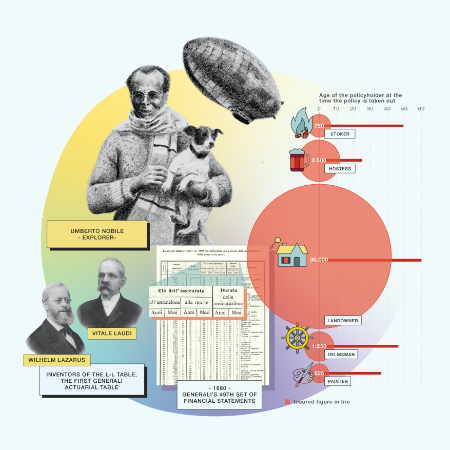Umberto Nobile and the dream of conquering the North Pole
31 July 1978
Umberto Nobile, one of the last Italian adventurers, passed away yesterday in Rome at the age of 93. He was an engineer and explorer, at a time when the latter were seen as almost mythical figures who pushed themselves to the boundaries of the known world.
At the beginning of the 20th century, the North Pole was one of those unknown boundaries.
Nobile had been there once in 1926, accompanying Roald Amundsen, a Norwegian explorer who aspired to conquer the Arctic.
The two of them did not actually touch the ground, but hung suspended above it, in the great northern skies, aboard the Norge, the airship that Nobile himself had designed for the mission.
The only form of conquest was the launch towards the frozen icefield of the Italian, Norwegian, and American flags: the flags of the three nations that had participated in the success of the venture.
But Nobile was ambitious and he wanted his feet to touch that frozen land, so two years later a new airship took off from a hangar in the Baggio area of Milan, this time called “Italia”, with Nobile, his dog Titina, and fifteen crew members on board.
The route was towards the North Pole.
The story of the Italia airship is sadly well-known: due to a storm and a failed landing, the cabin crashed into the ground, shattering and leaving ten men on the ice, one of whom would die from his injuries.
The other six remained in the airship which, carried away by the wind, disappeared into thin air, consigning itself and those men to oblivion. Their bodies would never be found.
Nobile remained on the ground with an injured leg and shoulder. The nine survivors put up a tent on the pack ice and painted it red to make it visible, and survived until help arrived. Nobile returned home an anti-hero; the fascism that had encouraged his adventures now disowned him. He was accused of abandoning the crew because he was rescued before the rest of his men. He retired to private life and moved first to Russia, then to the United States, where he continued his career as an aeronautical engineer.
He was rehabilitated after the war, when he ran as an independent candidate for the PCI and became one of its founders.
Nobile’s credibility has never been questioned: his military and technical training, his academic studies, and his undisputed leadership skills were an honour to this country.
If his deeds alone are not enough to prove his credibility, I would like to mention the documented insurance policies that Umberto Nobile had particularly wanted for himself and his crew as evidence that nothing was left to chance.
The policyholder was the Royal Italian Geographic Society, underwritten with various insurance companies including Assicurazioni Generali. A table indicates the beneficiaries in the event of death and the guaranteed capital, expressed in Italian lire. The greatest compensation concerned Nobile, for a total of 650,000 lire. The next highest reimbursements were those for engineer Trojani, for 300,000 lire and Natale Cecioni, for 200,000.
The insurance covered cases of death or permanent disability, including blindness, loss of limbs, or the “state of incurable mental alienation that renders the insured person permanently unable to hold down any job or occupation”. Any partial disability was compensated with a percentage of the total reimbursement, with each limb having a different value: an arm was worth more than a leg, and, incredibly, a right hand more than a left hand.
These policies were specifically requested by Nobile, and we reiterate here that they were made possible thanks to the foresight of insurance men who invented “actuarial tables”. People such as mathematician Vitale Laudi and self-taught genius Willhelm Lazarus, both Generali men, who, in an absolutely innovative way, conceived the company’s first actuarial table in 1877, known as the “LL Table”, which would cause the life insurance sector to take off.
Their tables, groundbreakingly based on the best databases of the time, lasted almost fifty years before being replaced by others based on public data deriving from population censuses.
While it was these innovations of calculus that made a mission like Nobile’s was possible, he can also take credit for an article of Italy’s constitution that promotes development and research today:
Article 9 of the Italian Constitution
“The Republic shall promote the development of culture and scientific and technical research.
It shall safeguard the natural landscape and the historical and artistic heritage of the Nation.
HISTORY

Marco Besso’s meeting at Generali with Vitale Laudi (mathematician, head of the Trieste life branch) and Wilhelm Lazarus, general agent of Hamburg, led to a groundbreaking renewal of the technical bases that paved the way for the great industrial development of life insurance for the company. Lazarus, a self-taught but recognised scientific authority, thoroughly understood the importance of data and, made use of his experience with the Berlin college of life insurance science for the German table, based on thousands of demographic data, on Generali’s behalf, developing specific but flexible criteria. In 1877 Laudi and Lazarus were the authors of the first Generali actuarial table (called L-L, from the initials of their surnames). They developed it using the best data in circulation (tens of thousands of cases) processed by a British commission between 1839 and 1843, equated in a new way compared to the Gompertz-Makeham formula, so that it could also be applied to those under the age of twenty. The result was exponential growth of the life branch, particularly in the Empire and in Italy. The L-L table remained valid until 1906, when it was replaced (for insurance in the event of death) by the G table, drawn up by Julius Graf, who succeeded Laudi as director of the life branch in Trieste.
